Fed Balance Sheet, Illustrated Edition
A while back, James Hamilton had a couple of posts on the recent explosion of changes to the Fed’s balance sheet. Being curious how the Fed’s balance sheet might have changed (if at all) in the couple months since, I decided to gin up my own set of pretty graphs, using the same H.4.1 Releases that Dr. Hamilton used. Herewith, the results of my labors:
Figure 1 – Factors Supplying Reserve Balances, December 2007 to date (*) (in billions of $)
Figure 2 – Factors Absorbing Reserve Balances, December 2007 to date (**) (in billions of $)
Figure 3 – Factors Absorbing Reserve Balances, Sept. 2008 to date (in billions of $)
Figure 3 is basically Figure 2, but zoomed in on the post-Lehman era.
Credit Easing
Although it’s tempting to view the expansion illustrated above as simply the Fed running the printing press, it’s not clear to me that this is in fact the case. The Fed views its current policies as being, in the main, variants on its traditional functions of 1) lender of last resort, & 2) stimulating the economy via lower interest rates. See, e.g., this recent article by the Dallas Fed. In this view, the Fed’s expanded balance sheet is one aspect of a de facto policy of regulatory forbearance, aimed at not only avoiding an even more serious economic downturn, but also keeping the banking system on life support ’till it’s able to earn its way back to health. Other aspects of this policy include FDIC guarantees for bank bonds, and (of course) TARP.
Although, IMHO, forbearance is less preferable than other courses of action, it is a potentially workable solution. It does depend, crucially, on the maintenance of strong loan underwriting by banks. In this regard, the recent tightening of lending standards by banks is actually an encouraging sign, since it suggests that they may not end up abusing forbearance the way the S&Ls did back in the ’80s. OTOH, forbearance inherently grants government leverage over banks. My concern is that the government might abuse such leverage to politicize credit allocation. IMHO, the mandatory participation of TARP institutions in the Obama housing bailout is one example of this. The recent experience of TARP banks in the Chrysler bankruptcy is another.
I’d like to think these incidents will be exceptions to the rule. But I’m not sanguine.
Irrelevant-But-Nifty Aside: 15 Minutes
In other (more important) news…Jennifer Peresie, a friend of mine, was recently interviewed by the New York Times, regarding a law review article she wrote a few years back. (Note also that said article was also recently mentioned in the Wall Street Journal.)
That’s way cooler than the Fed’s balance sheet….
Notes
(*) Notes for Fig. 1: Data from Tables 9-14 of the Fed’s H.4.1 Releases. Treasuries = U.S. Treasury securities; Other FR = Other Federal Reserve assets; Misc = Float + Gold stock + Special drawing rights certificate account + Treasury currency outstanding; Repo = Repurchase agreements; Discount = primary + secondary + seasonal credit; CB Swaps = Central bank liquidity swaps; TAC = Term auction credit; PDCF = Primary dealer and other broker-dealer credit; Maiden I = Net portfolio holdings of Maiden Lane LLC; AIG = credit extended to American International Group, Inc. + net portfolio holdings of Maiden Lane II and III; AMLF = Asset-Backed Commercial Paper Money Market Mutual Fund Liquidity Facility; CPFF = Net portfolio holdings of Commercial Paper Funding Facility LLC; Agency + MBS = Federal agency debt securities + Mortgage-backed securities; TALF = Term Asset-Backed Securities Loan Facility
(**) Notes for Figs. 2-3: Data from Tables 9 & 15-16 of the Fed’s H.4.1 Releases. Currency = Currency in circulation; Rev. Repo = Reverse repurchase agreements; Service = required clearing balance + adjustments to compensate for float; Other = Other liabilities and capital; Misc = Treasury cash holdings + foreign official accounts + other deposits; Excess Reserves = Reserve balances with Federal Reserve Banks (Table 9); Treasury = U.S. Treasury general account + supplementary financing account
Update 20090601:
A couple of additional figures that rearrange the data from Fig. 1, so as to (hopefully) better illustrating the size of the various Fed facilities:
Figure 4
Figure 5
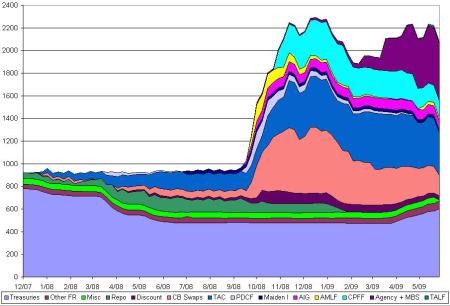
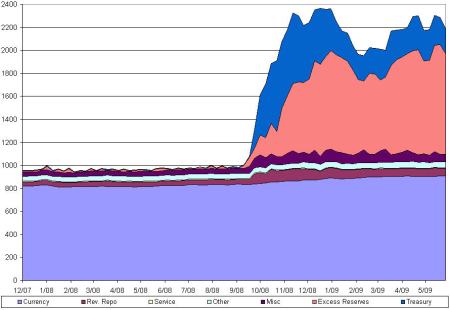
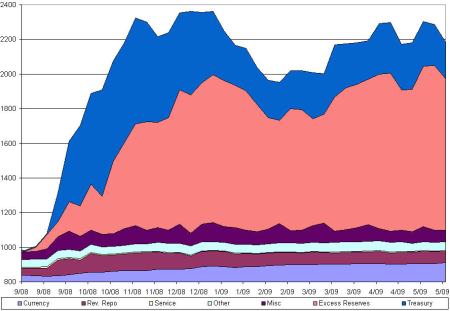
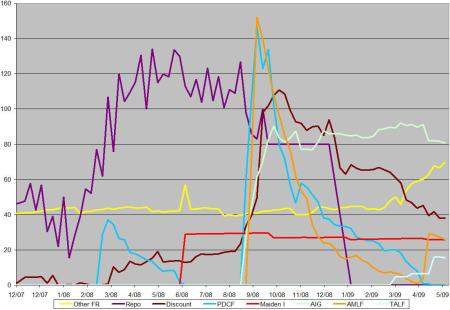
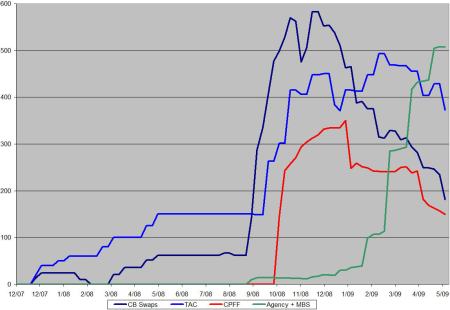
Leave a comment